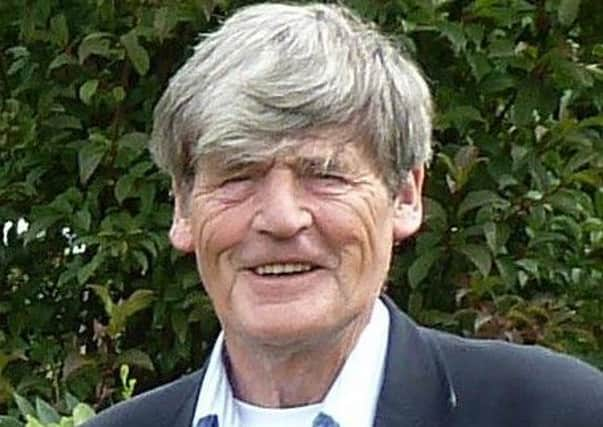Obituary: Robert Turnbull Haig Smith, artist and educator


Bob Smith simultaneously pursued two very successful careers as painter and teacher/administrator although, given the choice, the young Bob would have preferred to have been a farmer, an ambition born of holiday working, his love of the outdoors and an affinity with animals. Being the son of a Dunfermline police sergeant, and with no farm to inherit, that career option was closed and the determination and physical energy of the rock-climber and schoolboy rugby international was channelled along with his intelligence, sensitivity and creativity in another direction as he entered the Edinburgh College of Art. He gained diplomas with distinction at both undergraduate and postgraduate levels and had several of his paintings immediately accepted for the annual exhibition of the Royal Scottish Academy.
Soon after graduation, Bob married his fellow student, the painter, weaver and potter Susan K Senior.
Advertisement
Hide AdAdvertisement
Hide AdAfter training at Moray House College of Education, Bob taught art for two years at Darroch Secondary School before being appointed in 1965 as lecturer in design at the Edinburgh College of Domestic Science (interestingly, he was the first male member of staff at “Atholl Crescent”). In 1970 ECDS moved to a new campus on Corstorphine Hill and was soon renamed Queen Margaret College to reflect its expansion and the provision of a wide range of professional training and ultimately undergraduate level courses. Until retiring in 1993, Bob Smith played a key role in the institution’s rapid development, becoming in turn head of the new departments of design, of drama and of communication studies. In 1982 he was appointed assistant principal. Bob was a natural and inspiring teacher and was ideally suited to looking after student affairs. Bob was an outstandingly popular colleague and, to many, a supportive and loyal friend.
It is, of course, for his career as a painter that Bob Smith is known to a much wider public, principally through his many one-man exhibitions over the period 1969-1994 at the Scottish Gallery (Aitken Dott) and a plethora of group exhibitions in Edinburgh and beyond. His first solo exhibition in 1969 was hailed as being unusually mature. Perhaps the most concise analysis of Smith’s painting comes from Christopher Andreae:
“These paintings seem to have emerged out of some sort of archaeology of the imagination, a dream dig. They are like the rediscovery, by means of scrupulous investigation – aided by small touches of sensitive restoration – of ancient wall surfaces, of long buried, much over-layered symbols of mankind’s primal concerns: earth and sky, sun and moon and tide, wave motion and pattern, growth and the cycles of nature, metamorphoses of seed into root, into stem, into leaf and into berry.”
In these paintings nothing is hurried or superficial; Bob Smith did not hastily transfer sketches to canvas or board but thought deeply and allowed the logic of the physical process itself to contribute to the resolution of the concept. His work has a tactile almost as much as a visual appeal with apparently brushless layers of paint “scumbled, stained and impasted, then scraped, scratched, incised, gouged and scarred with lines or pitted textures, only to be glazed, dragged and stippled into the bargain” yet being “subtly polished as oiled bone” (Edward Gage). Of his abstract Afterwards (1976) the critic Martin Baillie, commenting on the fine surface of the painting, wrote: “…one longs to finger it as one does with a late Cezanne still-life.”
RTH Smith, the painter, was an accomplished, distinctive and consistent contributor to the Scottish art scene over four-and-a-half decades whose work is to be found in public and private collections in Britain, Australia, Canada, France, Italy and the USA. Some discerning patrons acquired substantial collections of his paintings, one of which formed the Hazel Heughan bequest to his former institution, now Queen Margaret University. Another bequest is destined for the Scottish Gallery of Modern Art.
After retiring from QMU, Bob continued to paint and to sell his work privately and to teach, principally in his popular winter courses over 12 years at the Green Park Hotel in Pitlochry. He was also able to pursue his beloved outdoor and practical pursuits, never more content than when he was acting as relief stockman for a herd of pedigree cattle or wielding a chainsaw or re-designing and extending his countryside home in Perthshire.
Bob died at home suddenly and unexpectedly, having just returned from tutoring an art class. The day before, he had given a lecture on the Scottish Colourists.
A successful painter, a first-class teacher, counsellor and tutor; a voracious reader; a capable administrator; a gregarious and generous colleague and friend; a loving and much loved family man; he would have been too modest to essay a self-portrait.
Bob Smith is survived by his wife Susan K Senior, son Alistair, daughter Harriet, daughter-in-law Karen and grand-daughter Olivia and grandson Lawrie.